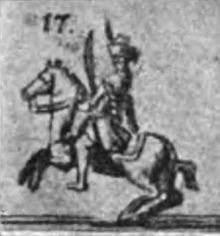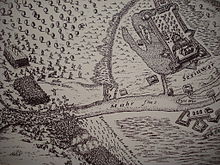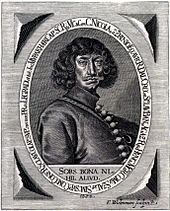Personal company Croatians on horseback
The body company Croats Ross ( Croatian Tjelesne kumpanije Hrvata konjanika ) was a 1660 from Croatian riders formed body company of the Elector Johann Georg II. Of Saxony . The Croatian bodyguard existed until shortly after the elector's death in 1680. Its long-time commander was the Croatian Count Janko Peranski († 1689) from 1661 to 1680 .

Probably the best known guardsman was Janko Šajatović alias Johann Schadowitz (1624–1704), who is considered the historical model of the Sorbian legendary figure Krabat .
history
Preconditions and advertising
As an expression of an absolutist claim to power based on the model of the French Sun King , medium-sized and smaller princes often maintained expensive court guards that were recruited abroad . During the Turkish Wars and the Thirty Years' War , the Croatian horsemen gained military fame and a reputation as notorious and feared fighters. This led to the establishment of Croatian life guards at various European royal courts . Elector Johann Georg II of Saxony was also one of her admirers, because Saxon regiments had felt the power of the Croatian cavalry in the course of the Thirty Years' War.
In order to advertise his own Croatian bodyguard, however, the elector needed the consent of the Croatian ruler, Emperor Leopold I. In a letter from Dresden on February 18, 1659 , the Croatian Ban Petar Zrinski was informed by the elector that the emperor had agreed to give Croats to the Saxon Send yard. Julius von Burckersroda wrote to the elector on March 23, 1659 that he had given the letter to the Ban and that he was ready to send Croats to Dresden. Baron Barbo , who was planned as the commander of the Croats , arrived in Vienna with proposals for a treaty, which the elector accepted on April 19, 1659. Two months later, Zrinski also agreed to the contractual agreements. The project was delayed in August of the same year, however, because Baron Barbo (who himself was not a Croat) was not recognized as a commander and Count Traschkowicz, who had been proposed instead, refused command. In addition, the Ban Petar Zrinski and his brother Nikolaus Zrinski were on retaliatory campaigns against the Turks at this time. In September, the passports issued by the Kaiser’s war chancellery arrived for the Croats. An imperial decree issued on September 6, 1659 in Pressburg , allowed the Croatian Count Janko Peranski with 20 Croatian riders to travel freely and unhindered to Saxony in order to enter the Electoral Saxon service . Like the Croatian Ban, the Peranski family came from a branch of the Šubić family . Finally, Georg Silly , “by birth one of Adell, a brave, intelligent man, also well fortunate”, took over the command of the Croatian bodyguard at the end of October 1659. Silly submitted his specific demands (including payment) and agreed a three-month notice period. The advertisements for the life guards were completed in early February 1660. The assembled troop, however, could not leave for Dresden immediately due to snow and flooding.
Sampling and installation
On March 15, 1660 "body-Compagnie Croats to Ross" was in Pirna from the Saxon electors patterned . The company at that time consisted of the commanding captain ( Croatorum capitaneus ) Rittmeister Georg Silly , the vice-captain Lieutenant Janko Peranski , a cornet , a sergeant with the rank of corporal , two further corporals, a Fourier , two trumpeters , 60 riders and 87 horses ( "Namely 8 men 1st sheet , 37 servants, 17 Croatian noblemen , 25 single horses "). These Croatian bodyguards received their monthly wages of 852 Reichstalers from the elector's private box.
After the draft and the taking of the oath , the Croatian bodyguard was first relocated to Meißen and finally to be housed in the Neu-Dresden Fortress (now the Inner Old Town ). The citizens complained about the lack of accommodation caused by the Croats and the unregulated payment of the considerable costs they caused. The Croatians invoked the free lodging promised to them by the elector .
As early as October 1, 1660, the unit was reinforced by 50 men and "their 1st sheet increased". In particular with regard to the Croats, the elector codified the service, discipline and military justice of his cavalry in the so-called "equestrian law" in the same year in order to remedy the deficient discipline .
On June 18, 1661, Rittmeister Silly received the order from the Elector to ensure that the Croats did not endanger the peace in the city. Silly died a little later and the Croatian bodyguards paid him their last respects at the funeral procession. His successor was Janko Peranski who was therefore promoted to Rittmeister on August 12, 1661. There is evidence that Peranski remained in command of the Croatian Life Guard until 1678 (but probably until the dissolution in 1680).
Turkish War 1663/1664

Only a few months after his appointment as Rittmeister, Peranski and the cornet baron Johann von der Goltz asked the elector for permission to leave for Croatia . They received permission to leave for the upcoming Turkish war in 1663/1664 . A letter from Peranski dated June 26, 1663 from Karlovac suggests that they were also accompanied by other Croatian guardsmen. The elector was informed about the fighting with the Turks in several letters. He also received several looted weapons as gifts, including three Ottoman matchlock rifles from Count Nikolaus Zrinski in 1664 , which are currently in the armory (Dresden) together with the gifts from the guardsmen .
When Johann Georg II, escorted by his Croatian bodyguard, entered the Reichstag in Regensburg in 1664, it caused a considerable stir. In 1666 the company under Rittmeister Peranski comprised 132 men; 75 in 1676.
After almost 12 years of service in the Croatian bodyguard, Kapitänleutnant Freiherr von der Goltz received his farewell on October 20, 1671. His successor was Johann Bartholomäus Bardarini von Kieselstein , who presented the elector with the flag of a janissary corps in 1675 (currently in the holdings of the armory).
1675 Peranski became the basis of merit by Captain Lieutenant Colonel promoted.
Without withdrawing direct command from Peranski, the Croatian bodyguard was placed under the orders of the elector, on July 25, 1677, under the high command of the colonel of the German bodyguard on Ross Rudolph von Neitschütz (1614–1682).
At the beginning of the “Most Serene Gathering”, the meeting of the elector with his brothers, the dukes of the three Albertine secondary school principalities, the Croatian bodyguard paraded in Dresden on February 1, 1678 under Captain Peranski and Vice-Captain Bardarini von Kieselstein.
Dissolution and further life paths
After the elector's death, the Croatian bodyguard was finally replaced by the subsequent elector Johann Georg III at the end of 1680 . Relocated to Zwickau and closed for cost reasons. The officers and guardsmen were released to their homeland.
The captain Janko Peranski had already bought Castle Brlog in Croatia in 1679 and returned to Croatia in 1681 after his end of service. After that, too, he often came to Saxony to visit the property he had acquired as Saxon governor of Moritzburg. Peranski died in Croatia in 1689.
The Vice-Captain, Lieutenant-Captain Johann Bartholomäus Bardarini von Kieselstein shot himself in his bed in the early morning of November 23, 1680 in the Gasthof Zum Golden Löwen (Jungnickel-Haus, now Bruno-Friedrich-Goedesche's bookstore) in Schneeberg (Ore Mountains) . The headshot from a three-bullet pistol shattered his skull and left bullet holes in the room. Bardarini is said to have been highly favored by the elector and therefore committed suicide after his death out of desperation and despair . As a suicide, he was only allowed a donkey burial : by official order, night guards buried him in silence on the night of December 7th at the local Wolfsberg .
The Rittmeister Janko Šajatović alias Johann Schadowitz continued to serve in the Saxon Garde du Corps and in 1690 became its commander due to his war experience, proven bravery in many battles and long service. He died as a squire in Saxony in 1704 and became the historical template for the Sorbian legend of the magician Krabat .
composition
From several draft lists it is known that the bodyguard consisted in the majority of native Croats , mainly experienced fighters. Among them were many Croatian nobles who had previously been in the service of Count Zrinski .
At their last known draft on January 3, 1678 in the electoral riding house at the Dresden Residenzschloss , the bodyguard included more Hungarians than Croats .
banner
The cornet of the Croatian Life Guard Georg Peranski presented in 1678 at the parade on the occasion of the "Most Serene Gathering"
A description of the flag in the inventory of the Türckische Cammer from 1674 shows that the flag was made of red taffeta and had crimson-silk fringes on the flag leaf . The flagpole was painted red and gold and had a triangular gold-plated tip with two crimson silk tassels .
Uniformity
Her uniform is said to have been in the style of the bodyguard of the generals on the Croatian military border. However, descriptions and pieces of uniform have obviously not survived. Gabriel Tzschimmer's best-known work "The Most Serene Gathering", commissioned by Elector Johann Georg II on the occasion of his meeting with his brothers, contains copper engravings on which the parading Croatian bodyguard can be seen and described.
See also
Sources and literature
- Holger Schuckelt: Croatian riders - horror and fascination in Saxony . In: Uwe Fiedler (ed.): The cup of the bitterest suffering: Chemnitz in the age of Wallenstein and Gryphius . Chemnitz Art Collection, Schlossbergmuseum, 2008, p. 100-107 .
- Holger Schuckelt: The Croatian bodyguard on the horse of Elector Johann Georg II of Saxony . In: Staatliche Kunstsammlungen Dresden (Ed.): Dresdener Kunstblätter . No. 5 , 2005, p. 320-329 .
- von Preradović: A contribution to the history of the establishment respectively. Equipment of the Electoral Saxon Body Company on Horseback “Croats” (1660–1680) . In: Association for historical weapons (Hrsg.): Journal for historical weapons . tape 3 . Dresden 1905, p. 358 ff . ( archive.org ).
- August von Minckwitz: The first electoral bodyguards on horseback and on foot and their history . Ed .: Georg von Schimpff. Dresden 1894.
- O. Schuster, FA Francke: History of the Saxon Army: from its establishment to the most recent times: Using handwritten and documented sources . tape 1 . Duncker & Humblot, 1885, p. 84-87 .
Individual evidence
- ↑ Excerpt from a copper engraving by Gabriel Tzschimmer : The most serene gathering or historical narration, what the most serene prince and lord, Mr Johann Georg der Ander, Duke of Saxony, etc., in the presence of His electoral serenity, most honored gentlemen, brothers of the wives, princes and princesses in peculiar honors and amusement in the Residenz un Haubt-Vestung Dresden in the month of February of the 1678th year with all kinds of acts, knightly exercises, shows, shooting, hunting, operas, comedy [...] Johann Hoffmann, Nuremberg 1680 (Tzschimmer's best-known work; originated in Commissioned by Elector Johann Georg II on the occasion of his meeting with his brothers, the dukes of the three Albertine secondary school principalities in 1678.).
- ↑ a b by Preradović: A contribution to the history of the establishment respectively. Equipment of the Electoral Saxon Body Company on Horseback “Croats” (1660–1680) . In: Association for historical weapons (Hrsg.): Journal for historical weapons . tape 3 . Dresden 1905, p. 358 ( archive.org ).
- ^ John VA Fine: When Ethnicity Did Not Matter in the Balkans: A Study of Identity in Pre-Nationalist Croatia, Dalmatia, and Slavonia in the Medieval and Early-Modern Periods . University of Michigan Press, 2010, ISBN 978-0-472-02560-2 , pp. 371 f .
- ↑ Letter of 20./30. October 1659 from Osaily . In: Sächsisches Hauptstaatsarchiv Dresden (SHStA) Loc. 9130/3, The Chur-Fürstl. Leibguardia der Croaten re. 1658–63.
- ^ O. Schuster, FA Francke: History of the Saxon Army: from its establishment to the most recent times: Using handwritten and documented sources . tape 1 . Duncker & Humblot, 1885, p. 84-87 .
- ^ Wilhelm Schäfer: Saxony Chronicle for the past and present . J. Blochmann, Dresden 1854, p. 171 ( digitized version in the Google book search).
- ^ Christian Meltzer : Historia Schneebergensis renovata. That is: Renewed city u. Mountain chronica of Wohl-loebl, located in the Ober-Ertz mountains of the praised Meißens. Freyen Berg-Stadt Schneeberg [etc.] Heinrich Fulde, 1716, p. 1045 .
- ↑ August von Minckwitz: The first electoral bodyguards on horseback and on foot and their history . Ed .: Georg von Schimpff. Dresden 1894, p. 40 .
- ↑ Gabriel Tzschimmer : The most serene gathering or historical narration, what the most serene prince and lord, Mr Johann Georg der Ander, Duke of Saxony, etc. in the presence of His electoral serenity, most honored gentlemen, brothers of the wives, princes and princesses to strange honors and amusement in theo Residenz un Haubt-Vestung Dresden in the month of February of the 1678th year with all kinds of acts, knightly exercises, shows, shooting, hunting, operas, comedies [...] Johann Hoffmann, Nuremberg 1680, p. 38 (Tzschimmer's best-known work; commissioned by Elector Johann Georg II on the occasion of his meeting with his brothers, the dukes of the three Albertine secondary school principalities in 1678.).

